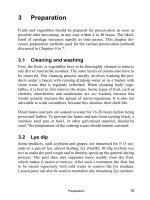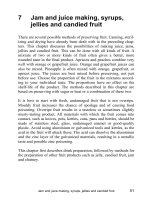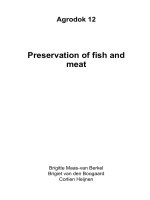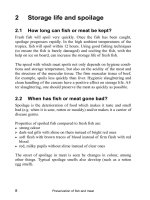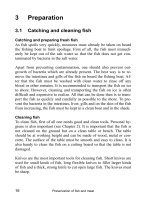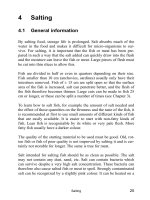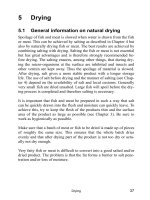Preservation of fish and meat - Part 5 pps
Bạn đang xem bản rút gọn của tài liệu. Xem và tải ngay bản đầy đủ của tài liệu tại đây (250.67 KB, 9 trang )
Drying
37
5 Drying
5.1 General information on natural drying
Spoilage of fish and meat is slowed when water is drawn from the fish
or meat. This can be achieved by salting as described in Chapter 4 but
also by naturally drying fish or meat. The best results are achieved by
combining salting with drying. Salting the fish or meat is not essential
but has great advantages and is therefore strongly recommended be-
fore drying. The salting ensures, among other things, that during dry-
ing the micro-organisms at the surface are inhibited and insects and
other vermin are kept away. Thus the spoilage of material is slowed.
After drying, salt gives a more stable product with a longer storage
life. The use of salt before drying and the manner of salting (see Chap-
ter 4) depend on the availability of salt and local customs. Generally
very small fish are dried unsalted. Large fish will spoil before the dry-
ing process is completed and therefore salting is necessary.
It is important that fish and meat be prepared in such a way that salt
can be quickly drawn into the flesh and moisture can quickly leave. To
achieve this, try to keep the flesh of the products thin and the surface
area of the product as large as possible (see Chapter 3). Be sure to
work as hygienically as possible.
Make sure that a batch of meat or fish to be dried is made up of pieces
of roughly the same size. This ensures that the whole batch dries
evenly and that after drying part of the product is not too dry or actu-
ally not dry enough.
Very fatty fish or meat is difficult to convert into a good salted and/or
dried product. The problem is that the fat forms a barrier to salt pene-
tration and/or loss of moisture.
Preservation of fish and meat
38
5.2 Preparation
Salting (see Chapter 4) is part of the preparation for drying, and de-
pends among other things on the availability of salt and on local cus-
toms.
After salting, the excess water formed must be removed from the fish
or meat. With meat, it can be done by passing the larger pieces of meat
through a wringer (two wooden rolls 1.5-2.0 cm apart). In doing so,
the surface area is also increased which reduces the time needed for
drying. A somewhat simpler method for removing moisture is to press
meat and (mainly whole) fish.
Put the fish on a clean, level surface and, using sheets of e.g. wood
with weights on them, press the fish or meat as flat as possible.
Subsequently the fish and meat is hung up before drying to speed up
the drying process.
5.3 Hanging fish and meat up to dry
Fish can be hung up in several ways on horizontal sticks to dry. It is
advisable to hang fish on hooks or with string tied around the tails
(Figure 9).
Figure 9: Drying fish
Drying
39
Meat to be dried is hung on hooks or on strings. The pieces of meat
are then evenly spaced on sticks hanging horizontally in such a way
that the pieces of meat do not touch (Figures 10 and 11).
Figure 10: Hanging up strips of meat on hooks and strings
Figure 11: Simple construction of wood for drying meat
With this method of drying, air is free to circulate all around the meat
and the product will dry quickest and most uniformly. If there is no
free air circulation, some parts will remain moist. Spoilage by bacteria
or insect damage (they are carriers of bacteria) can especially start at
such places.
Preservation of fish and meat
40
Whole fish, fish fillets or meat can also be dried on drying racks made
of chicken wire or bamboo poles (Figure 12). The disadvantage of this
method is that, due to the contact between the meat or fish and the
poles or wire, there is a chance the product will remain moist in places
and thus cannot dry completely.
Figure 12: Drying racks with horizontal and downward sloping dry-
ing surfaces
5.4 The drying process
Drying must take place carefully and uniformly. The best results are
achieved in dry weather with a lot of wind. Take care that the meat or
fish does not get so hot the fat starts to melt or that a crust is formed
on the surface. The inside of the fish or meat would then stay moist
which would make it spoil quickly. Therefore do not put the meat or
fish to be dried directly in the sun at the start of the drying process. In
the early morning or the late afternoon sun, the product to be dried
will stay relatively cool, but in the middle of the day it must be pro-
tected against overheating by temporarily putting it in the shade. Ex-
perience will teach you what the best method is.
Drying
41
If drying racks are used, the pieces of fish or meat must be turned
every two hours so they dry uniformly. The product to be dried must
be protected as much as possible against vermin and insects. Insects
are carriers of various bacteria which can cause the product to spoil.
Bluebottle or carrion flies lay their eggs on the still damp product and
their larvae eat the flesh. Beetles of the species Dermestes lay their
eggs especially in the already dried product. Try to prevent such in-
sects from nestling in or near the material to be dried. To do so, re-
move all animal waste from the immediate vicinity. This is a highly
suitable breeding place for these kinds of insects. Using a good salting
technique helps to keep the insects at a distance during drying. Also
use mosquito netting to keep insects, and especially the bluebot-
tle/carrion flies, away. Do not let the netting touch the material to be
dried.
Put the drying rack at least one metre above the ground so that other
vermin do not get a chance to get to the product. Put the legs of the
rack in a pan of water to which a little oil has been added.
The meat or fish must be protected against dusty wind, rain and dew.
The products can be covered with banana or palm leaves or plastic.
They can of course also be put under an awning or in a shed. How-
ever, put the products to be dried out in the sun again as soon as possi-
ble to let them dry further.
5.5 Dried fish and meat: storage and use
Fish
How long fish must dry depends on the type of fish, its size and the
weather. The final moisture content must be less than 25% to prevent
microbial spoilage. Weighing the fish before and after the drying
process can tell you whether the fish is dry enough. If during the dry-
ing process the weight of the fish does not decrease further, it is suffi-
ciently dry. In general, naturally dried fish needs about 3-10 days to
dry. After drying, the dried fish is difficult to bend. Some of the dried
Preservation of fish and meat
42
fish products are very crumbly and breakable and must be handled
with care after being dried.
In dry climates it is possible to store dried fish in sealable, sturdy
boxes or wooden crates in which ventilation holes have been made.
The holes must be covered with mosquito netting to keep out insects
and vermin.
In humid conditions dried fish can take up moisture from the air and
must be packed airtight. An additional advantage of airtight packaging
is a delay in the onset of rancidity in fatty fish. Strong plastic bags can
be used which are then closed properly. These provide protection
against insects and moisture. However, the bags should not be placed
in the direct sun or in warm places. The product can then start sweat-
ing; there is, after all, some moisture left. This moisture can cause
mould to grow on the fish. When such moisture is seen, the fish
should be re-dried in the sun for several hours and re-packed.
Store the packed, dried fish in a cool, dry, well-ventilated and dark
place.
Before unsalted or salted dried fish can be eaten, it must first be
soaked in clean, cold water for 48 hours. In very warm weather, the
fish should not be left standing longer than that. The water must be
replaced several times by clean, fresh water. Fish can also be broken
into smaller pieces before being soaked. If the fish is very salty, it can
be slowly heated in water (until just before boiling) for about 1 hour.
However, preserved fish, whether salted, dried and/or smoked, must
eventually always be heated to 100 °C (212
0
F) before being eaten!
Meat
Experience will help you determine when meat is dry enough. Often
this is after 5 days, depending on the weather. Well-dried meat has a
uniform appearance after being broken. The colour is the same
throughout the product and is often dark red. The consistency is hard
and when it is pushed with a finger, it does not give. The smell and
Drying
43
taste of dried meat is different to that of fresh meat. Light oxidation of
the meat fats gives a typical dried meat taste. Meat which has any
signs of spoilage should not be stored any longer nor eaten.
After drying, the meat can be packed and stored. In dry climates it is
possible to store dried meat in sealable, sturdy boxes or wooden crates
in which ventilation holes have been made. These holes must be cov-
ered with mosquito netting to keep out insects and vermin. One can
also store-dried meat in closed (jute) bags hung from the ceiling to
keep out any vermin. In humid conditions dried meat can take up
moisture from the air and must be packed airtight. Strong plastic bags
can be used which are then closed properly. Keep the packed meat in
a cool, dry, well-ventilated and dark place. In such conditions, well-
dried meat can be kept for months.
Before using salted or unsalted dried meat, it must first be soaked in
boiling water or be boiled gently. How long the meat is soaked or
heated depends on the desired taste and consistency.
5.6 Solar drying
Natural drying of fish and meat sometimes has disadvantages. Long
periods of sunshine are required, the drying speed is slow and in areas
with a relatively high humidity it is often difficult to dry the fish and
meat adequately. An alternative for conventional sun drying is solar
drying.
Improved sun drying for fish
A solar tent dryer can be used for solar drying. This is the simplest and
cheapest way of solar drying. Solar dryers work by retaining the heat
of the sun's rays. A higher drying temperature and thus greater drying
speed can then be achieved. The moisture content of the final product
is lower than that achieved with conventional sun drying. All this
means that the chance of spoilage occurring during the drying process
and storage is smaller. The higher temperatures in a tent dryer slow
down bacterial growth on and in the product and kill insects and their
Preservation of fish and meat
44
larvae if they are present in the product. Product loss due to insect
damage is thus less than with sun drying.
A tent dryer (Figure 13) is almost completely sealed so the product is
protected against rain, dust, vermin, etc. Inlet and outlet openings can
be covered with taped-on pieces of mosquito netting if necessary. All
these factors ensure that the final product is of higher quality.
Figure 13: Solar tent dryer
It is relatively easy to make a tent dryer and it requires little material.
The dryer consists of a tent-shaped frame of bamboo or wooden poles
covered with a piece of strong plastic. For the sun side of the tent and
the two sides, transparent plastic is used. For the shadow side and the
ground, black plastic is used. The black plastic absorbs and retains the
heat from the sun. Along the whole length in the middle of the tent a
drying rack is placed on which the products are spread. Put the drying
rack about 30 cm above the ground. By opening one side panel the
Drying
45
drying rack can be put inside the tent. Close this side again well by
putting sand or stones on the base of the plastic (see Figure 13).
The transparent plastic on the front side is wrapped around a stick at
the bottom. In this way the plastic can be rolled up or let down to al-
low air into the tent and to regulate the temperature a bit. The air en-
tering is heated in the tent and absorbs moisture when it flows past the
fish on the rack. The humid air can leave the tent through both air out-
lets in the top of the tent.
A disadvantage of tent dryers is that they are light in weight which
makes them susceptible to damage in windy weather. The tent dryer
also requires the use of a lot of plastic, which can be costly.
Experience will help you determine when the fish is dry enough and
can be packed. The drying time depends on the kind and the size of
the fish.

